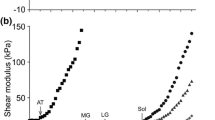Abstract
The aim of this study was to calculate the theoretical variation of the nonlinear damping factor (B) as a function of the muscle shortening velocity, and then to compare the theoretical values with the experimental data obtained on both the elbow flexor and the ankle extensor muscles. The theoretical variation of the B factor was determined from a muscle model consisting of a contractile component in parallel with a viscous damper both in series with an elastic component, and by using, the charateristic equation of the force velocity curve. In this muscle model, the viscous element modelled the inability of the muscle to generate as big a contracting force (while shortening) as possible under isometric conditions. Eight volunteer subjects performed maximal concentric elbow flexions and ankle extensions on an isokinetic ergometer at angular velocities of 60, 120, 180, 240, 300 and 360°·s−1, and held two maximal isometric actions at an elbow angle of 90° (0° corresponds to the full extension) and at an ankle angle of 0° (0° corresponds to the foot flexion of 90° relative to the leg axis). From these measurements, the force and the shortening velocity values of each muscle were determined by using a musculo-skeletal model of the joint. The results showed that the theoretical behaviour of the B factor would seem to be dependent on the shortening velocity and on the parameter which varies according to the muscle fibre type composition and affects the curvature of the force-velocity curve (af). For each muscle group, the experimental data of B fitted with the theoretical equation, and the best fit was obtained for an of of 0.28 for the ankle extensor and of 0.32 for the elbow flexor muscles. These results indicated that from the muscle model used in the present study it is possible to describe the mechanical behaviour of the muscle during maximal concentric action.
Similar content being viewed by others
References
Asmussen E, Hansen O, Lammert O (1965) The relation between isometric and dynamic muscle strength in man. Dan Nat Assoc Infant Paralysis 20:3–11
Bahler AS (1967) Series elastic component of mammalian skeletal muscle. Am J Physiol 213:1560–1564
Cavagna GA (1970) Elastic bounce of the body. J Appl Physiol 29:279–282
Close R (1964) Dynamic properties of the fast and slow skeletal muscles of the rat during development. J Physiol 173:75–95
Close R (1969) Dynamic properties of the fast and slow skeletal muscles of the rat after nerve cross-union. J Physiol 204:331–346
Close RI (1972) Dynamic properties of mammalian skeletal muscles. Physiol Rev 52:129–197
Fenn W (1935) Muscular force at different speeds of shortening. J Physiol 85:277–297
Gasser H, Hill AV (1927) The dynamics of muscle contraction Proc Roy Soc 96:398–437
Gransberg L, Knutsson E (1983) Determination of dynamic muscle strength in male with acceleration controlled isokinetic movements. Acta Physiol Scand 119:317–320
Gravel D, Richards CL, Filion M (1988) Influence of contractile tension development on dynamic strength measurements of plantar flexors in man. J Biomech 23:89–96
Hill AV (1922) The mechanism of muscular contraction. Physiol Rev 2:310–341
Hill AV (1938) The heat of shortening and the dynamic constants of muscle. Proc R Soc B (London) 126:136–195
Hill AV (1950) The series elastic component of muscle. Proc R Soc B (London) 137:273–280
Kojima T (1991) Force-velocity relationship of human elbow flexors in voluntary isotonic contraction under heavy loads. Int J Sports Med 2:208–213
Martin L, Pousson M, Morlon B (1993) Effect of electrical stimulation training on the contractile characteristics of the triceps surae muscle. Eur J Appl Physiol 67:457–461
Niku S, Henderson JM (1989) Viscosity of the flexor muscles of the elbow joint under maximum contraction condition. J Biomech 22:523–527
Pertuzon E, Bouisset S (1971) Maximum velocity of movement and maximum velocity of muscle shortening. Med Sport 6:170–173
Ralston H, Polissart M, Inman V, Close J, Feinstein B (1949) Dynamic features of human isolated voluntary muscle in isometric and free contractions. J Appl Physiol 1:526–533
Taylor NA, Sanders RH, Howick EI, Stanley SN (1991) Static and dynamic assessment of Biodex dynamometer. Eur J Appl Physiol 62:180–188
Wells JB (1965) Comparison of mechanical properties between slow and fast mammilian muscles. J Physiol 178:252–269
Wickiewicz TL, Roy RR, Powell PL, Edgerton VR (1984) Muscle architecture and force-velocity relationships in humans. J Appl Physiol 57:435–443
Wilkie DR (1950) The relation between force and velocity in human muscle. J Physiol 110:249–280
Woledge RC (1961) The thermoelastic effect of change of tension in active muscle. J Physiol 155:187–208
Zuurbier CJ, Huijing PA (1992) Influence of muscle geometry on shortening speed of fibre, aponeurosis and muscle. J Biomech 25:1017–1026
Author information
Authors and Affiliations
Rights and permissions
About this article
Cite this article
Martin, A., Martin, L. & Morlon, B. Theoretical and experimental behaviour of the muscle viscosity coefficient during maximal concentric actions. Eur J Appl Physiol 69, 539–544 (1994). https://doi.org/10.1007/BF00239872
Accepted:
Issue Date:
DOI: https://doi.org/10.1007/BF00239872




